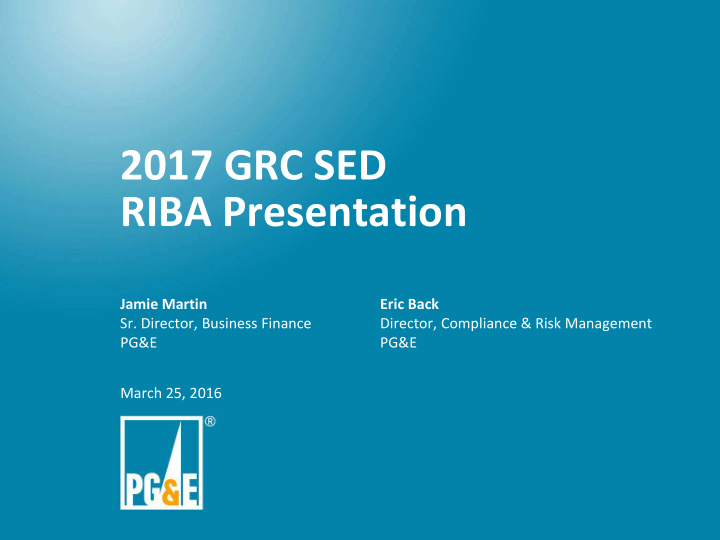



2017 GRC SED RIBA Presentation Jamie Martin Eric Back Sr. Director, Business Finance Director, Compliance & Risk Management PG&E PG&E March 25, 2016
Integrated Planning & RIBA Session D Session 1 This session focuses on PG&E’s top risks This session discusses strategies for and compliance issues. The RET score is managing LOB priorities, including plans used to rank risks from an event, asset, or sset, or for top risks process level Session D Session 2 Session 1 RIBA RIBA RIBA ensures that risk informs prioritization discussions; RIBA scores Session 2 ide identify the safety, environmental, and/or reliability risks that each project or This Session prioritizes resources needed program aims to prevent in order to execute strategy 2
RIBA – Scoring Overview Impact Levels • RIBA is a process that provides a common framework for evaluating Negligible Minor Moderate Major Extensive Severe Catastrophic work 1 2 3 4 5 6 7 Frequency Level • Work is evaluated in three Common 10 32 100 316 1,000 3,162 10,000 components: safety, reliability, (7) and the environment Regular 6 18 56 178 562 1,778 5,623 (6) • Frequency Frequent Scores for each component are 2 7 23 74 234 740 2,340 (5) derived by determining the frequency and impact of the worst Often 2 7 21 67 211 668 2,113 (4.5) reasonable direct consequence of not performing the work Occasional 2 6 18 56 178 562 1,778 (4) Infrequent 1 4 14 43 135 427 1,351 • In addition to the score, work is (3) also categorized by drivers such as Rare 1 3 10 32 100 316 1,000 regulatory compliance, (2) commitment, inter-relationship to Remote other work, etc. 1 2 6 18 56 178 562 (1) Note : Each project can mitigate safety, environmental, and reliability risks. These scores are calculated independently and added together. The maximum possible score is 30,000 and the minimum score is 2 (due to rounding). 3
What Does RIBA Provide? Transparency: Consistency: Comparability: • • Increases • Moves toward a Increases transparency into more consistent risk- comparability of prioritization informed approach work portfolios decisions to internal to the evaluation across LOBs during and external and prioritization of prioritization stakeholders work within and discussions across LOBs Key Components of the Process: • A common framework for evaluating work. All capital and expense projects and programs are scored based on safety, reliability, and environmental impacts, and work drivers such as compliance requirements, commitments and financial benefits are flagged • Models and subject mater expertise are used to make prioritization decisions. Model outputs are calibrated and challenged by subject matter experts to arrive at prioritization decisions 4
��������������� � ������������������������������� � ����������������������������������������������� ��� ������������� � ������������������������������ ��� ������������� ��� ��� � ���������������������������������������������� ��� � ��������������������������������� ��� ������������� � ��� ������������� � ��������������������������������������� � ������������������������������ � � � � � � � � � ����� � �������������������� ����������� �������� ������ ��������� �������� ������������� ����� � ����� �� ��������������������������������������������������������� ����� ��������������� �� ��������������������������������������� ��� ���������������� �� ��������������� ����� �� ��� ��� ������������� ����� ������������� ����� ��������������� �� ���������������������������������������������������������� ������������� ����� � �������������������������������������� ����� ������������� �� ���������������������������������������� ����� ������������� �� �������������������������������������� ������������� ��� �� ���������������������������������� ����� ������������� �� ������ ����������� �� �������������������� � � � How RIBA informs the GRC forecast Projects are scored along Scorers present their Prioritization discussions are Confidence using the RIBA three dimensions methodology to the broader based on risk scores and flags process to make budget group to ensure standard as well as other decisions in current and Safety application of scoring and considerations (e.g., system future years Reliability flagging taxonomy and execution constraints) RIBA is a tool that helps to Environmental Projects are calibrated within risk inform the GRC forecast Projects are flagged based on and then across the LOB the driver(s) of the work portfolios Risk-Informed Score Calibrate Prioritization Discussion Leadership across the LOB Executive leadership RIBA expanded scoring team Subject matter experts participates participates Impact Levels Negligible Minor Moderate Major Extensive Severe Catastrophic Frequency 1 2 3 4 5 6 7 Level 7 10 32 100 316 1,000 3,162 10,000 Frequency 6 6 18 56 178 562 1,778 5,623 5 2 7 23 74 234 740 2,340 4.5 2 7 21 67 211 669 2,115 4 2 6 18 56 178 562 1,778 3 1 4 14 43 135 426 1,348 2 1 3 10 32 100 316 1,000 1 1 2 6 18 56 178 562 5
How RIBA informs the GRC forecast – Electric Operations All Electric Operations Projects We start the process by scoring every single project/ project category using RIBA methodology Score every project using RIBA Mandatory • Work that we have to do Regulatory Compliance • regardless of the RIBA score New Business/WRO • Use Requirements and Commitment/Rule20A Commitment Flags to • differentiate work In-flight • Other considerations used for Use Other Consideration Inter-relations • prioritization Flags to differentiate work Support • Projects are prioritized considering RIBA score and impacts to key metrics and initiatives No Flag Projects 6
Recommend
More recommend